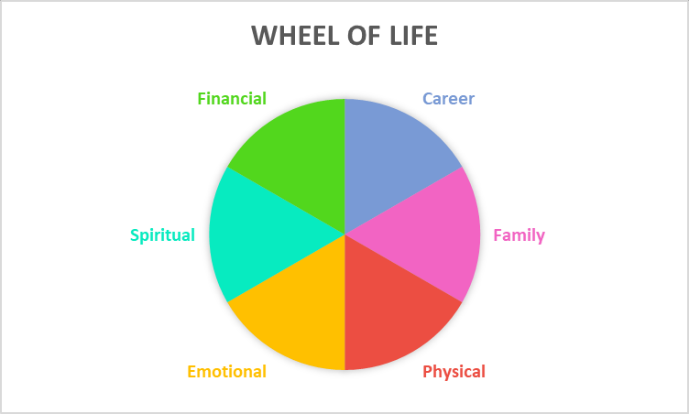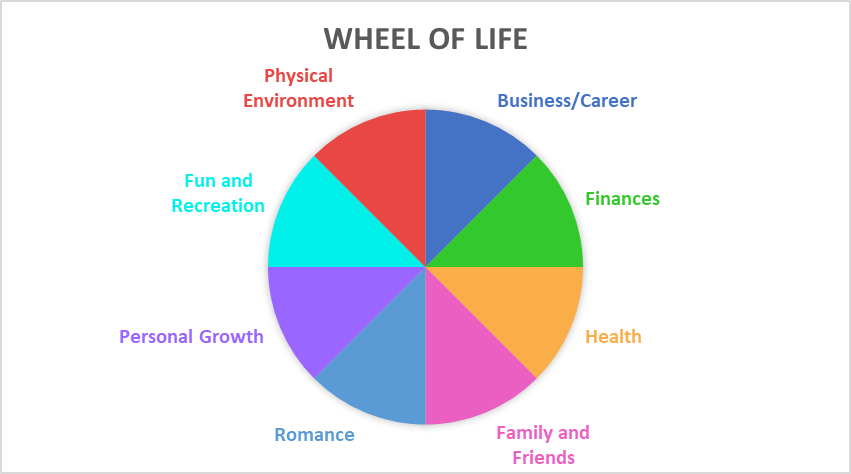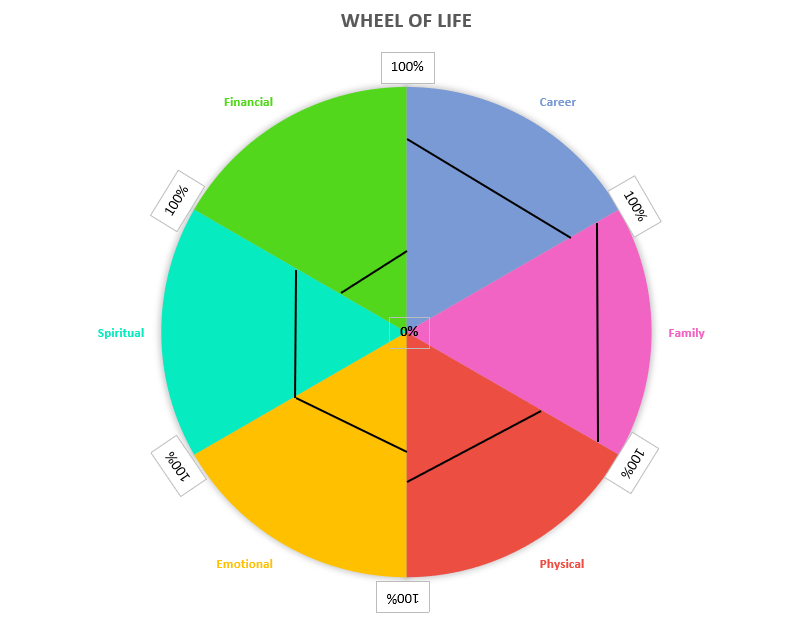Goal Setting Steps - How to Set and Reach Goals in 7 Easy Steps
There are seven simple goal setting steps you can take for goal reaching success. Follow this process to map out where you want to be and take steps to get there with ease.

7 Easy Goal Setting Steps for Success
Step 1: Evaluate Your Life Balance
Start by evaluating your life balance. What is your satisfaction level in the key areas of your life? A very useful tool recommended by life coaches and used in personal development circles is the Wheel of Life.
Note: This step is a direct input into the goal setting process (and ongoing evaluation).
Create a pie chart (or wheel) equally divided by the key areas of your life. Refer to the two charts below for examples of categories to include:
 Example 1 |
 Example 2 |
The circle represents your life, the whole of you. The pieces of the pie, sometimes referred to as spokes or pillars, are the parts or categories of your life: the areas, roles, or pieces of the whole.
You assess those aspects (or categories) by creating a graphic (like the two above) to see how balanced your life is.
Tip: Customize your wheel based on the categories that represent the whole of your life. Divide the categories into equal parts within the circle or wheel.
Remember, the idea of this goal setting step is to evaluate each area your life to see which areas need attention.
You can evaluate by assigning percentages or using a scale of 1 to 10.
This example below focuses on 6 life areas and uses percentages for measuring satisfaction.
Scoring 100% in an area represents maximum satisfaction.

In this example, notice that the Family category received a great score at 80%; however Financial satisfaction came in low at 20%. Spiritual and Emotional were both scored at 40%. This makes sense since Spiritual and Emotional satisfaction can go hand-in-hand.
Imagine that this is a tire on a car, how would the car perform? Would it drive smoothly? How long would the tire last?
Peak performance happens when all areas are balanced.
You need to find a way to create balance in your life, focusing your time and energy into the areas that are most important to you. This will ensure peak performance at the highest level.
Step 2: Analyze Each Category (Area) of Your Life
Make a list for each category of your life. Within each category, list the areas you will focus on for improvement. You do this by brainstorming a list of areas you must improve on to feel fulfilled.
Based on the example of the Wheel of Life above, there is significant room for improvement in the Financial category. A brainstormed list of areas for improvement might look like the following:
Financial
- Increase Income
- Pay off Debt
- Reduce Expenses
Once you’ve completed a list for each category, the next goal setting step is to visualize.
Step 3: Create a Vision
Create a vision for each category of your life. Two methods for capturing your vision include writing (or journaling) and creating a vision board. Create a vision journal and combine both methods by adding drawings or pictures to your entries.
This goal setting step is your chance to dream big and get creative! What inspires you in each area of your life? Are there phrases or quotes that motivate you? What about a story or someone else’s achievement? What does your dream home look like? How will you feel when you reach your goal weight or finish a marathon?
Your vision is your ultimate outcome and will motivate you to follow through and keep you focused on achieving results.
Step 4: Find Your Purpose
Why do you want to achieve this outcome (your vision)? What will it bring you? What makes you want your dream home? Will the spacious back yard allow your children more space to play? Will extra bedrooms allow family and friends to visit more often?
The key to this goal setting step is to ask the right questions that will guide you to your purpose, which is the driving force for taking the action required to reach your goals and being open to change in your life. When you know what you’re moving toward, you’ll work to find ways to make it a reality.
When it comes to setting goals, the “Why” comes before the “How”.
Remember: Reasons come first, then the answers.
Step 5: Create Your Goal Action Plan Using the S.M.A.R.T. Goal Method
S.M.A.R.T is an acronym used to create measurable, achievable goals. SMART goals provide you with a straightforward, easy to use framework for the goal setting process. This concept provides focus, clarity, definition and motivation to follow through on achieving your goals.
S.M.A.R.T. stands for:
Specific - Being specific makes it easier to visualize the process and outcome of achieving your goals.
Measurable - Be as precise as possible when setting your goals. Establishing a measurement allows you to track your progress and know when your goals are achieved.
Achievable - A goal that is unattainable will cause frustration and lack of motivation.
Realistic - In a perfect world you would have six hours a day to improve on a skill or train for a marathon. Accept that your time is limited and set goals that fit your schedule and lifestyle.
Time-Bound - Clear timelines create focus as well as a sense of urgency. Timelines keep you focused on completing actions more quickly than if there were no target dates identified.
Create goals that promote balance in all areas of your life.
Step 6: Stay Accountable and Track Your Progress
Review you goals and track your progress regularly. Are you on-track meeting timelines? If you are behind, what will it mean to adjust your targets? Can you adjust your focus and give more time and energy to the goal that is lagging? How will this affect the other areas of your life (life balance)?
Checking your progress is your opportunity to course correct before your fall behind or lose focus. This goal setting step also gives you the opportunity to reassess your goals and ensure they continue to align with your vision.
Step 7: Reflect on Your Accomplishments and Celebrate!
Reflecting on your accomplishments and celebrating allows you to pause and appreciate the results of your hard work and dedication before moving to the next phase of your goal plan or beginning the journey towards your next goal.
Part of reflection is evaluating what worked and areas for improvement.
Celebrate the wins and learn from your mistakes.







